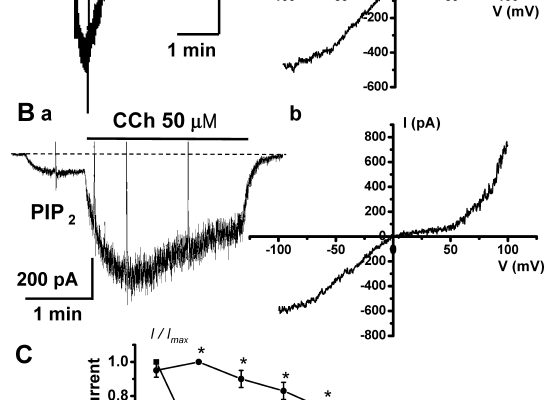 Byung Joo Kim, Min Tae Kim, Ju-Hong Jeon, Seon Jeong Kim, Insuk So
Byung Joo Kim, Min Tae Kim, Ju-Hong Jeon, Seon Jeong Kim, Insuk So
(a) Center for Bio-Artificial Muscle and Department of Physiology, Seoul National University College of Medicine; Seoul
110–799, Korea
(b) Center for Bio-Artificial Muscle and Department of Biomedical Engineering, Hanyang University;
Seoul 133–791, Korea
*Corresponding author.E-mail: insuk@plaza.snu.ac.kr.
원문 링크 : https://www.jstage.jst.go.jp/article/bpb/31/9/31_9_1733/_article
Abstract
The classic transient receptor potential channel (TRPC) is a candidate for Ca2-permeable cation channel in mammalian cells. TRPC5 is desensitized rapidly after activation by G protein-coupled receptor. Here we investigate the mechanisms of desensitization of TRPC5 using patch-clamp recording. TRPC5 was initially activated by muscarinic stimulation using 50mM carbachol (CCh) and decayed rapidly in the presence of CCh (desensitization). Intracellularly-applied phosphatidylinositol 4,5-bisphosphate (PIP2) slowed the rate of desensitization. In contrast, several other phosphoinositides, including PI(3,4)P2, PI(3,5)P2, PI(3,4,5)P3 and PI(4)P, had no effect on the desensitization of the TRPC5 current. This indicates that PIP2 attenuates the desensitization of the TRPC5 current in a highly selective manner. Neither wortmannin, an inhibitor of phosphatidylinositol 4-kinase, or poly-L-lysine (PLL), a scavenger of PIP2, had any effect on desensitization of the TRPC5 current. PIP2 breakdown appears to be a required step in the desensitization of TRPC5 current, but PIP2 depletion alone was insufficient for channel desensitization. TRPC5 was inhibited by cytochalasin D treatment. In mouse ileal myocytes, the desensitization of CCh-activated inward current (ICCh) also slowed in the presence of PIP2 in recording pipettes. These results indicate that PIP2 is involved in the desensitization of TRPC5 currents.